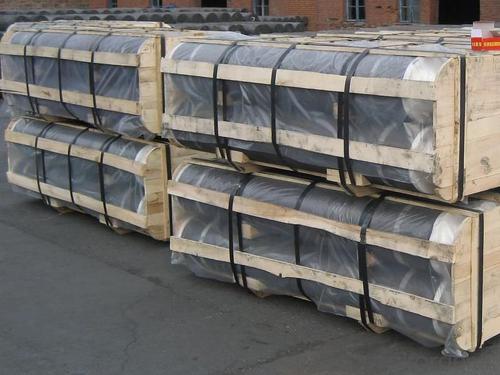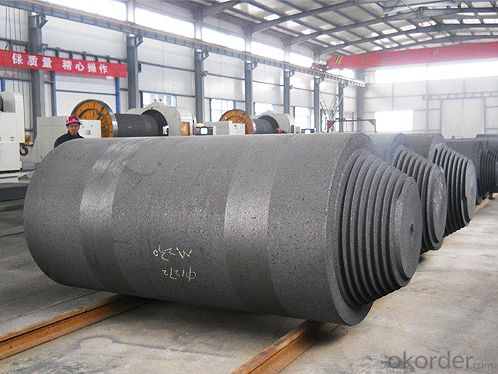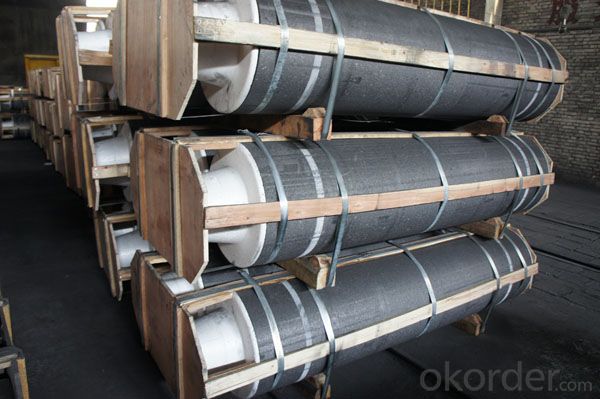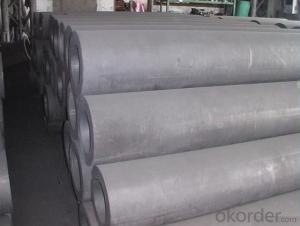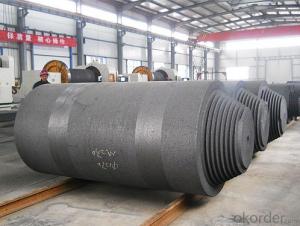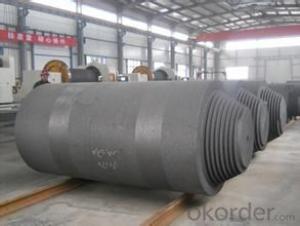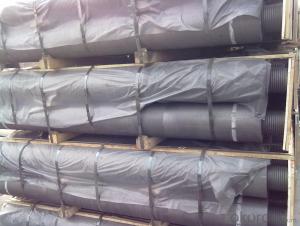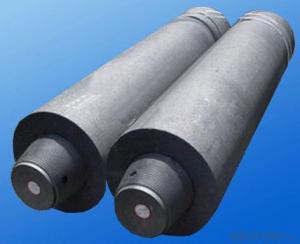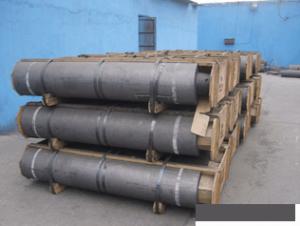Carbon Electrode With Φ750~Φ960 S Grade
- Loading Port:
- Tianjin
- Payment Terms:
- TT OR LC
- Min Order Qty:
- 20 m.t.
- Supply Capability:
- 800 m.t./month
OKorder Service Pledge
OKorder Financial Service
You Might Also Like
Carbon Electrode With Φ750~Φ960 S Grade
Graphite/Carbon Electrode Paste Specification
| PARAMETER UNIT GUARANTEE VALUE | ||||||
| Items | Φ500~Φ700 | Φ500~Φ700 | Φ750~Φ960 | Φ750~Φ960 | Φ1020~Φ1400 | Φ750~Φ960 |
| Rs μΩ.m | ≤45 | ≤38 | ≤45 | ≤38 | ≤40 | |
| Bulk Desity g/cm3 | ≥1.55 | ≥1.58 | ≥1.55 | ≥1.58 | ≥1.55 | ≥1.58 |
| Bending Strength MPa | 3.5~7.5 | 4.0~7.5 | 3.5~7.5 | 4.0~7.5 | 3.5~7.5 | 4.0~7.5 |
| Compressive Strength MPa | ≥20.0 | ≥20.0 | ≥20.0 | ≥20.0 | ≥19.0 | ≥19.0 |
| Compressive Strength MPa | 3.2~4.8 | 3.0~4.6 | 3.2~4.8 | 3.0~4.6 | 3.2~4.8 | 3.0~4.6 |
| Ash % | ≤2.5 | ≤2.0 | ≤2.5 | ≤2.0 | ≤2.5 | ≤2.0 |
Features
1:carbon eletrode
2:for ferroalloy,calcium carbide, silicon metal, manufacture
Product Description
Carbon Electrode is abaked electrode used in submerged arc furnaces for delivering power to the charge mix. Electrode is added to the top of the electrode column cylindrical form. Electrode is essentially a mix of Electrically Calcined Anthracite (ECA) or Calcined Petroleum Coke (CPC) with Coal Tar Pitch and is baked for weeks, it is widly used for ferroally productiong, silicon metal production etc.
Picture
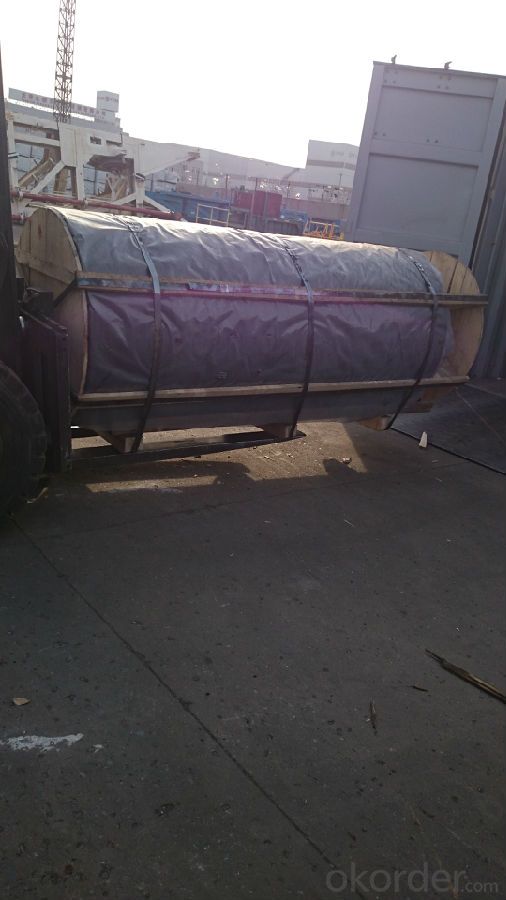
We Also supply all kind of carbon electrode paste and below materials, please contact us if you have any enquiry about it.
Calcined Anthracite
Calcined Petroleum Coke
Coke (Met Coke, Foundry Coke, Semi Coke)
- Q: What are carbon credits and how do they work?
- Carbon credits are a market mechanism designed to reduce greenhouse gas emissions. They work by assigning a monetary value to each ton of carbon dioxide or other greenhouse gases that are not released into the atmosphere. This value is assigned through a process called carbon offsetting, which involves investments in projects that reduce emissions, such as renewable energy projects or reforestation initiatives. These projects generate carbon credits, which can be bought and sold by companies or individuals to offset their own emissions. By purchasing carbon credits, entities can effectively compensate for their own carbon footprint and contribute to global efforts in mitigating climate change.
- Q: What is carbon PC?
- Polycarbonate (PC), polycarbonate is a molecular chain containing [O-R-O-CO] chain thermoplastic resin according to the molecular structure of the ester can be divided into aliphatic, alicyclic and aromatic type of fat, which has the practical value of the aromatic polycarbonate, and bisphenol A polycarbonate as the most important, molecular weight is usually 3-10 million.Polycarbonate, English Polycarbonate, referred to as PC.PC is a kind of amorphous, odorless, non-toxic, highly transparent colorless or slightly yellow thermoplastic engineering plastics, has excellent physical and mechanical properties, especially excellent shock resistance, tensile strength, bending strength, compressive strength and high creep; small size is stable; good heat resistance and low temperature resistance, mechanical properties, stability in a wide range of temperature dimensional stability, electrical properties and flame retardant properties, can be used for a long time at -60~120 deg.c; no obvious melting point, a molten state at 220-230 DEG C; the molecular chain rigidity, melt viscosity and high water absorption resin; small, small shrinkage, high precision, good dimensional stability, permeability of films is small; self extinguishing materials; stable to light, but not UV resistance, good weather resistance; oil resistance, acid and alkali resistance, no oxygen acid and amine, Ketones are soluble in chlorinated hydrocarbons and aromatic solvents. They are easy to cause hydrolysis and cracking in water for a long time. Because of their poor fatigue resistance, they are prone to stress cracking, poor solvent resistance and poor wear resistance
- Q: How does carbon impact soil health?
- Carbon is essential for maintaining soil health as it acts as a key component of organic matter. It helps improve soil structure, water holding capacity, and nutrient availability, thereby promoting the growth of beneficial soil microorganisms and enhancing overall soil fertility.
- Q: How does carbon pricing work?
- Carbon pricing is an approach that utilizes the market to decrease greenhouse gas emissions by placing a value on carbon emissions. This is achieved by assigning a financial cost to the release of carbon dioxide and other greenhouse gases into the atmosphere, which greatly contribute to climate change. There exist two primary forms of carbon pricing mechanisms: carbon taxes and cap-and-trade systems. Under a carbon tax, a fixed price per metric ton of carbon emissions is established, and emitters are obligated to pay this tax according to their emissions. The tax can be imposed at different points in the supply chain, such as during extraction, production, or consumption. The goal of a carbon tax is to create a economic deterrent for emitting carbon and motivate industries and individuals to reduce their emissions. On the other hand, cap-and-trade systems impose a limit or cap on the total amount of carbon emissions permitted within a specific jurisdiction. This cap is divided into allowances, which represent the right to emit a particular amount of carbon. These allowances are either distributed or auctioned to emitters in the form of permits. Emitters can then trade these permits amongst themselves in a market. If an emitter surpasses their allocated allowances, they must purchase additional permits from those who have surplus allowances. This establishes a market-based incentive for emission reduction, as those who can more cost-effectively decrease their emissions can sell their excess allowances to those who are unable to. Both carbon taxes and cap-and-trade systems aim to incorporate the cost of carbon emissions into the economy, making pollution more expensive and encouraging the adoption of cleaner technologies and practices. By assigning a value to carbon, these mechanisms provide economic signals that urge businesses, industries, and individuals to invest in low-carbon alternatives, energy efficiency, and innovation. Additionally, they generate revenue for governments, which can be utilized to fund efforts in climate change mitigation and adaptation, renewable energy projects, or to reduce other taxes. Overall, carbon pricing mechanisms are designed to establish economic incentives for reducing greenhouse gas emissions, facilitating the transition to a low-carbon economy, and mitigating climate change. While they may not be a perfect solution, they are widely acknowledged as one of the most effective tools for driving emission reductions and combating climate change.
- Q: How do plants and trees absorb carbon dioxide?
- Plants and trees absorb carbon dioxide through a process called photosynthesis. During photosynthesis, they use sunlight, water, and chlorophyll to convert carbon dioxide into glucose and release oxygen as a byproduct. This helps in reducing the amount of carbon dioxide in the atmosphere and contributes to maintaining a balance in the Earth's carbon cycle.
- Q: How does carbon impact biodiversity?
- Carbon impacts biodiversity in several ways. Firstly, carbon dioxide is a greenhouse gas that contributes to climate change, leading to shifts in temperature and precipitation patterns. These changes can disrupt ecosystems and alter habitats, affecting the distribution and survival of various species. Additionally, excess carbon in the atmosphere can lead to ocean acidification, which negatively affects marine biodiversity by harming coral reefs and other organisms reliant on calcium carbonate structures. Finally, deforestation and land-use changes associated with carbon emissions result in habitat loss, further reducing biodiversity. Overall, carbon emissions have significant and detrimental impacts on the delicate balance of ecosystems and the diversity of life on Earth.
- Q: 14 is the upper left corner of the mark, please answer a bit more detailed, thank you!
- The fastest and easiest way:Enter 14C first, then select 14, and press CTRL+SHIFT+ '+'.
- Q: Stability, primary carbon, two carbon, three carbon, four carbon
- In hydrocarbon molecules, with 3 hydrogen atoms of carbon atoms is called the first carbon atom (also called a carbon atom or primary carbon atom); with 2 hydrogen atoms of the carbon atoms is called second carbon atom (also called the two carbon atoms or secondary carbon atoms); with 1 hydrogen atoms of the carbon atoms is called third carbon atoms (also called the three carbon atom or tertiary carbon atoms)
- Q: What are the impacts of carbon emissions on the stability of estuaries?
- Carbon emissions have significant impacts on the stability of estuaries. Increased carbon dioxide levels in the atmosphere lead to ocean acidification, which affects the pH balance of the water in estuaries. This acidification can disrupt the delicate balance of species within the estuary ecosystem, leading to declines in populations of organisms such as oysters, clams, and other shellfish. Additionally, carbon emissions contribute to global warming, which can lead to rising sea levels and increased storm intensity, both of which can cause erosion and loss of habitat in estuaries. Overall, carbon emissions have the potential to disrupt the stability and functioning of estuaries, threatening their biodiversity and ecological services.
- Q: What are the different types of carbon-based alloys?
- There exists a variety of carbon-based alloys, each possessing distinct properties and applications. Some of the most prevalent types are as follows: 1. High carbon steel: Boasting a high carbon content, typically ranging from 0.6% to 1.5%, this alloy is renowned for its exceptional strength and hardness. Accordingly, it finds suitability in the manufacturing of tools, knives, and automotive components. 2. Low carbon steel: Commonly referred to as mild steel, this alloy features a lower carbon concentration, generally below 0.3%. Its malleable and ductile nature renders it ideal for applications requiring shaping and welding, such as construction and automotive parts. 3. Stainless steel: A popular choice, stainless steel incorporates chromium, nickel, and other elements. As a result, it exhibits remarkable resistance to corrosion and staining. It is frequently utilized in the production of kitchen utensils, medical equipment, and construction materials. 4. Cast iron: Possessing a higher carbon content, typically ranging from 2% to 4%, this alloy excels in heat retention. Consequently, it finds extensive usage in the manufacturing of cookware, pipes, and engine blocks. 5. Tool steel: Engineered specifically for the fabrication of cutting tools, this alloy generally contains a high carbon concentration, typically between 0.7% and 1.4%. It offers exceptional hardness, wear resistance, and heat resistance. 6. Carbon fiber reinforced polymers (CFRP): These alloys consist of carbon fibers embedded within a polymer matrix. They exhibit lightweight properties, immense strength, and notable stiffness. Consequently, they are highly suited for applications in the aerospace, sports equipment, and automotive industries. As a whole, carbon-based alloys present a vast array of properties and applications, rendering them versatile materials within numerous industries.
Send your message to us
Carbon Electrode With Φ750~Φ960 S Grade
- Loading Port:
- Tianjin
- Payment Terms:
- TT OR LC
- Min Order Qty:
- 20 m.t.
- Supply Capability:
- 800 m.t./month
OKorder Service Pledge
OKorder Financial Service
Similar products
Hot products
Hot Searches



